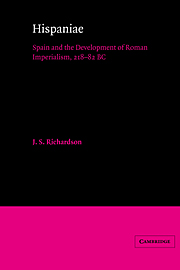Book contents
- Frontmatter
- Contents
- List of maps
- Preface
- Abbreviations
- 1 Spain and Roman imperialism
- 2 Spain before the Romans
- 3 The war zone: 218–206
- 4 Continuity and adaptation: 206–194
- 5 The shaping of the provinciae: 193–155
- 6 The consular provinciae: the wars in Spain 155–133
- 7 From provinciae to provinces: 133–82
- 8 Rome, Spain and imperialism
- Appendices
- Bibliography
- Index
1 - Spain and Roman imperialism
Published online by Cambridge University Press: 07 September 2009
- Frontmatter
- Contents
- List of maps
- Preface
- Abbreviations
- 1 Spain and Roman imperialism
- 2 Spain before the Romans
- 3 The war zone: 218–206
- 4 Continuity and adaptation: 206–194
- 5 The shaping of the provinciae: 193–155
- 6 The consular provinciae: the wars in Spain 155–133
- 7 From provinciae to provinces: 133–82
- 8 Rome, Spain and imperialism
- Appendices
- Bibliography
- Index
Summary
The Roman senate first assigned Spain as a provincia in 218 BC. According to Livy, the meeting, held probably in March, ordered that Hispania should be one of the two areas named for the consuls of the year, the other being ‘Africa with Sicily’. Thereafter Spain appeared on the annual list of provinciae throughout the period of the republic, usually, after 197 BC, in the form of two areas, Hispania citerior and Hispania ulterior, nearer and further Spain; and indeed remained under the control of Roman forces and Roman governors at least until the Vandal invasions in the fifth century AD.
The early part of this prolonged involvement of Rome in Spain coincided with the growth of Roman power throughout the Mediterranean basin, beginning in the third century with the wars against Carthage and reaching a climax in the middle of the first century in the wars of the imperial republic in East and West under the command of Pompey and Caesar. It is not surprising therefore that it is on this period in particular that attention has been focussed in the attempt to determine the nature of Roman imperialism. Imperialism is not a static phenomenon, but a process of aggressive acquisition leading to the establishment of some type of domination by one national group over others. None would doubt that by the end of the republic Rome had acquired such domination over most of the peoples of the Mediterranean, and of some, notably in Spain, Gaul and the East, who lived a considerable distance from it.
- Type
- Chapter
- Information
- HispaniaeSpain and the Development of Roman Imperialism, 218–82 BC, pp. 1 - 10Publisher: Cambridge University PressPrint publication year: 1986

